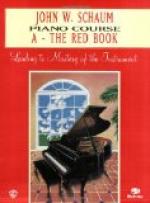At the appointed hour that afternoon, we drove through the busy rue de Clicy, and halted at the number which had been indicated. It proved to be one of those unpromising French apartment buildings, which present, to the passer-by, a stern facade of flat wall, broken by rows of shuttered windows, which give no hint of what may be hidden behind them. In this case we did not find the man we sought in the front portion of the building, but were directed to cross a large, square court. The house was built around this court, as was the custom in constructing the older sort of dwellings.
At last we discovered the right door, which was opened by a neat housekeeper.
“M. Pugno is not here, he lives in the country,” she said, in answer to our inquiry. (How difficult these French musicians are to find; they seem to be one and all “in the country"!)
“But, madame, we have an appointment with M. Pugno; will you not be good enough to see if he is not here after all?”
She left us standing, but returned almost immediately with the message that M. Pugno had only that moment entered his studio, to which she would conduct us.
[Illustration: RAOUL PUGNO]
In another moment we had crossed the tiny foyer and were standing within the artist’s sanctuary. At first glance one felt as though in an Oriental chamber of some Eastern monarch. Heavy gold and silver Turkish embroideries hung over doors and windows. The walls were covered with many rare paintings; rich objets d’art were scattered about in profusion; an open door led out into a pretty garden, where flowers bloomed, and a fountain dripped into its marble basin. A raised dais at one side of the room held a divan, over which were draperies of Oriental stuffs. On this divan, as on a throne, sat the great pianist we had come to see. He made a stately and imposing figure as he sat there, with his long silvery beard and his dignified bearing. Near him sat a pretty young woman, whom we soon learned was Mlle. Nadia Boulanger, a composer and musician of brilliant attainments.
“I regret that I am unable to converse with you in English, as I speak no language but my own,” began M. Pugno, with a courteous wave of the hand for us to be seated.
“You wish to know some of my ideas on piano playing—or rather on teaching. I believe a child can begin to study the piano at a very early age, if he show any aptitude for it; indeed the sooner he begins the better, for then he will get over some of the drudgery by the time he is old enough to understand a little about music.
TRAINING THE CHILD
“Great care must be taken with the health of the child who has some talent for music, so that he shall not overdo in his piano study. After all a robust physical condition is of the first importance, for without it one can do little.
“A child in good health can begin as early as five or six years. He must be most judiciously trained from the start. As the ear is of such prime importance in music, great attention should be paid to tone study—to listening to and distinguishing the various sounds, and to singing them if possible, in solfeggio.




